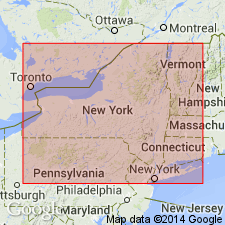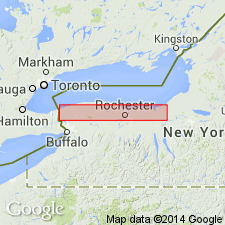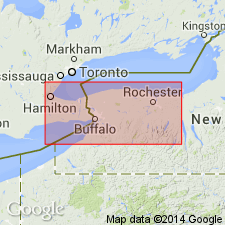
- Usage in publication:
-
- Medina sandstone
- Modifications:
-
- Named
- Dominant lithology:
-
- Sandstone
- AAPG geologic province:
-
- Appalachian basin
Summary:
Unit called red sandstone of Oswego in former reports, here referred to as Medina sandstone. Predominant color is red, more rarely whitish and greenish. Confined to Oswego Co., to high grounds of Oneida at Florence village, and others parts of town of Florence, and to extreme northern parts of Onondaga and Cayuga Cos., NY. Occupies stratigraphic position between Oneida conglomerate above and Salmon River sandstone below.
Source: GNU records (USGS DDS-6; Reston GNULEX).

- Usage in publication:
-
- Medina sandstone
- Medina series
- Medina shales and sandstones
- Medina group*
- Medina formation
- Medinan series
- Medina White sandstone
- Red Medina series
- Grey Medina sandstone
- Medina period-series
- Modifications:
-
- Overview
- AAPG geologic province:
-
- Appalachian basin
Summary:
In succeeding years [post-1843] some New York geologists placed Oneida conglomerate beneath Medina sandstone (see details under Oneida conglomerate), and the upper gray portion of the Medina came to be known as "Medina gray sandstone," "Upper Medina," and "White Medina"; while the lower red portion was called "Medina red sandstone," "Medina red sandstones and shales," "Red Medina," and "Lower Medina." The use of the name Medina was also extended to Canada, Pennsylvania, New Jersey, maryland, Virginia, West Virginia, Kentucky, Georgia, Ohio, and Indiana, for rocks believed to correspond to all or some part of typical Medina of New York.
In 1891 (Smithsonian Inst. 45th Ann. Rpt. Bd. Regents, p. 252-253) G.K. Gilbert stated that at Niagara Falls, beneath Clinton group and extending downward for several hundred feet, is a great bed of soft sandy shale, interrupted, so far as we know, by a single hard layer, a sandstone ledge 10 to 20 feet thick.
In 1893 (GSA Bull., v. 4, p. 116-117) C.S. Prosser gave stratigraphic position of the Medina between Clinton above and "Oswego sandstone or Oneida conglomerate" below, and gave its thicknesses, in different parts of the State, as 400 (central New York) to 1,075 (western New York).
In 1899 (New York State Geol. 16th Ann. Rpt., p. 199-226) D.D. Luther used Medina group to include Medina sandstone (740 feet at Syracuse) and "underlying" Oneida conglomerate (25 to 100 feet); and F.J.H. Merrill (New York State Mus. Bull., v. 4, no. 91) also used Medina in these two senses. The same year (Sci., n.s., v. 10, p. 874-878) J.M. Clarke and C. Schuchert stated that Medina sandstone underlies Clinton and overlies Oneida conglomerate, and that "it is = Oswego sandstone of Vanuxem" [Vanuxem used Grey sandstone of Oswego]. They also introduced Oswegan period or group to include Medina sandstone and Oneida conglomerate. In 1899 (GSA Bull., v. 10, p. 135) G.K. Gilbert stated that in type district, about Medina, New York, Medina formation is 800 feet thick, and consists chiefly of red shale with beds of soft argillaceous sandstones, usually white or gray, in upper 100 feet.
Source: US geologic names lexicon (USGS Bull. 896, p. 1335-1339).

- Usage in publication:
-
- Medina sandstone
- Medina series
- Medina shales and sandstones
- Medina group*
- Medina formation
- Medinan series
- Medina White sandstone
- Red Medina series
- Grey Medina sandstone
- Medina period-series
- Modifications:
-
- Overview
- AAPG geologic province:
-
- Appalachian basin
Summary:
In 1901 (New York State Mus. Bull. 45) A.W. Grabau applied Medina series to the beds between Clinton above and Oswego sandstone below, and gave their thickness as 1,200 feet at Niagara Falls and vicinity. In Buffalo Soc. Nat. Hist. Bull. 6, no. 1, p. 20-21, 1901, he called the same rocks Medina sandstone and gave 1,266+/- feet as thickness in Niagara region; and he used Oswegan group to include Medina sandstone and underlying Oswego sandstone or Oneida conglomerate.
In 1902 (New York State Mus. Bull. 52, table opp. P. 658) E.O. Ulrich and C. Schuchert gave position of Medina as between Clinton above and Oneida below, as did several other geologists in succeeding years. In 1905 (Sci., n.s., v. 22, p. 528-535) A.W. Grabau stated that lower 1,100 feet of the Medina represents Richmond time, and he assigned these beds to Ordovician. In 1906 (New York State Mus. Bull. 92, p. 120-124) Grabau applied Medina sandstones to upper 125 feet of Medina rocks and Medina shales and sandstones to underlying 1,140 feet, and again expressed opinion that latter beds are of Richmond [Ordovician] age. In 1907 (New York State Mus. Bull. 114) C.A. Hartnagel stated "there is evidence which may show that all the Oswego and probably part of the [overlying] Medina could with propriety be included with the Lower Siluric" [Ordovician].
In 1908 (Sci., n.s., v. 27, p. 622-623) A.W. Grabau restricted Medina sandstone to "Upper Medina or Medina proper" of previous usage, and introduced Queenston shales for the 1,100 feet of red Medina shales of previous usage, which he stated are of Richmond age and which he assigned to Ordovician. (The Queenston is unfossiliferous in western New York, but is now generally conceded to be = beds not far distant in Ontario that carry a Richmond fauna.) He also included Medina sandstone as thus restricted and Oneida conglomerate in the Clinton. The same year (Sci., n.s., v. 28, p. 347) G.H. Chadwick proposed Lewiston shale for the same shale that Grabau named Queenston, and he also assigned it to Ordovician, and restricted Medina to post-Queenston beds, which he included in the Niagaran. (Because of priority of publication Queenston is name now used by geologists.) In 1909 (Jour. Geol., v. 17, p. 238) A.W. Grabau applied Whirlpool sandstone to the 25 feet of white quartzose sandstone forming basal member of "true or Upper Medina" and resting on the beds of Richmond age.
Source: US geologic names lexicon (USGS Bull. 896, p. 1335-1339).

- Usage in publication:
-
- Medina sandstone
- Medina series
- Medina shales and sandstones
- Medina group*
- Medina formation
- Medinan series
- Medina White sandstone
- Red Medina series
- Grey Medina sandstone
- Medina period-series
- Modifications:
-
- Overview
- AAPG geologic province:
-
- Appalachian basin
Summary:
In 1911 (GSA Bull., v. 22) E.O. Ulrich applied Medina sandstone to the post-Queenston part of the original Medina (which he included in Silurian and correlated with Oneida conglomerate), and assigned the older and unconformable Lewiston (Queenston) shale and the underlying Oswego sandstone to Ordovician.
In 1912 (New York State Mus. Hdbk. 19) C.A. Hartnagel included Queenston (Lewiston) shale in Medina beds, and assigned all to Silurian.
In 1913 the term Albion was suggested by J.M. Clarke as a name for the post-Queenston part of the Medina, to which Grabau and Chadwick were restricting the name Medina sandstone. (See Albion sandstone.) The same year E.O. Ulrich (GSA Bull., v. 24, p. 107-108) recommended that Medina "be retained in its original significance," and that it be called Medina series, a "term equivalent in rank to Niagaran"; also that "Lower Medina" be called Juniata (a well-established Pennsylvania name), instead of Queenston shale, more recently proposed; and he transferred the Richmond (and the Queenston) to Silurian. In 1913 (12th Intl. Geol. Cong., Canada) Ulrich used Medinan as a series term to cover Albion sandstone and Richmond (Queenston shale), both of which he assigned to Silurian. In Niagara folio of USGS, No. 190, 1913 (Paleozoic geology by E.M. Kindle), Medina group was used to include Albion sandstone (Silurian) and Queenston shale (Silurian or Ordovician), the latter formation not having yielded fossils, and its age being questioned by some geologists. The same year (Canada Geol. Survey Gdbk. 4, p. 127-140) W.A. Parks proposed that Medina be still further restricted, by removal of Whirlpool sandstone and some 80+/- feet of overlying red and gray shales included in Albion sandstone as defined, but to which Schuchert in 1913 applied name Cataract formation. Parks stated that Cataract formation of Schuchert represents an invasion from north and west at commencement of Silurian time. In GSA Bull., v. 24, p. 461-463, 1913, A.W. Grabau included in top of the Medina of Niagara Gorge 6 feet of beds which he designated as Sodus shale, a member that had previously been assigned to the Clinton.
In 1914 (Sci., n.s., v. 39, June 19, p. 915-918) E.M. Kindle disclaimed responsibility for use of names Albion sandstone and Medina group in Niagara folio, and expressed opinion that Grabau's application of Medina to beds above base of Whirlpool sandstone "is the usage which the writer believes should and will prevail," and that Albion sandstone should be dropped. Kindle proposed that these beds be called Medina formation. He included Thorold sandstone in his Medina formation. This usage was followed by M.Y. Williams (1914 and later rpts.), who also referred Queenston shale to Ordovician, and stated that 'Whirlpool sandstone overlapped it; and by C. Schuchert, 1914 (GSA Bull., v. 25, Sept., p. 277-320), although some of Schuchert's sections restricted Medina sandstone to beds above his Cataract formation [now said to correspond to lower part of Albion sandstone]. Schuchert stated that Grabau's restriction of Medina to beds above the [unfossiliferous] Queenston shale was "altogether correct," for "at Medina along Oak Orchard Creek one practically sees only these red and white sandstones characterized by the well-known fauna."
Source: US geologic names lexicon (USGS Bull. 896, p. 1335-1339).

- Usage in publication:
-
- Medina sandstone
- Medina series
- Medina shales and sandstones
- Medina group*
- Medina formation
- Medinan series
- Medina White sandstone
- Red Medina series
- Grey Medina sandstone
- Medina period-series
- Modifications:
-
- Overview
- AAPG geologic province:
-
- Appalachian basin
Summary:
In 1918 (GSA Bull., v. 29, p. 327-368) G.H. Chadwick still further restricted Medina at top, by removing Thorold sandstone member (5 feet thick), and applying Medina to the beds between base of Thorold sandstone and base of Whirlpool sandstone.
In 1923 (Maryland Geol. Survey Silurian vol., p. 244, 267, 347, etc.) E.O. Ulrich and R.S. Bassler transferred top member (Thorold sandstone) of Albion sandstone and of Medina group to Clinton formation, and used Medinian to include this restricted Albion sandstone and the unconformably underlying Queenston shale, both of which they assigned to Silurian. They proposed that Albion be retained for the "sandy facies that prevails in New York and rather generally in Appalachian Valley," and used Alexandria group to cover Albion sandstone and contemporaneous deposits. In same vol. C.K. Swartz used Medinan series to cover only Tuscarora formation (=Albion sandstone), and assigned the underlying Juniata sandstone (=Queenston shale) to Ordovician. In Denison Univ. Bull., Jour. Sci. Lab., v. 20, p. 50-51, 1923, A.F. Foerste included in Medinan only the rocks to base of Whirlpool sandstone, or those equivalent to Albion sandstone.
The 1924 ed. Of Schuchert's Textbook of geology used Alexandrian as time term for post-Richmond part of the original Medina. Two reports of West Virginia Geol. Survey (Rpt. On Mineral and Grant Counties, 1924, and Rpt. On Mercer, Monroe, and Summers Counties, 1926, both by D.B. Reger) used Medina White sandstone (instead of Tuscarora sandstone), Red Medina series (instead of Juniata formation), and Grey Medina sandstone (basal 250 to 300 feet of Silurian System and said to be = Oswego sandstone of New York), because Medina has long priority. I.C. White, then State Geologist of West Virginia, used same classification in 1926 (GSA Bull., v. 37, p. 509). A 1924 rpt. Of Ohio Geol. Survey (4th ser., Bull. 28, by W. Stout and R.B. Lamborn, chart opp. P. 358 and elsewhere) included in Medina beds all rocks between base of Sodus shale and base of Queenston shale. The Pennsylvania Geol. Survey included in Medina period-series the Tuscarora sandstone (=Albion sandstone), the Juniata formation (=Queenston shale), and the Oswego sandstone, according to Pennsylvania Geol. Survey, 4th ser., Bull. M7, by B.L. Miller, p. 57-60, 1925, and G.H. Ashley, State Geologist, GSA Bull., v. 37, p. 510, 1926. The 1916 geol. Map of Virginia applied Medina to Tuscarora sandstone (=Albion sandstone) and placed Juniata formation in Ordovician. E.O. Ulrich, 1926 (GSA Bull., v. 37, p. 279-348) used Medinan to include all beds between base of Clinton and base of Richmond. The 1928 geol. Map of Virginia used Tuscarora sandstone and Juniata formation, and included both in Silurian.
Source: US geologic names lexicon (USGS Bull. 896, p. 1335-1339).

- Usage in publication:
-
- Medina sandstone
- Medina series
- Medina shales and sandstones
- Medina group*
- Medina formation
- Medinan series
- Medina White sandstone
- Red Medina series
- Grey Medina sandstone
- Medina period-series
- Modifications:
-
- Overview
- AAPG geologic province:
-
- Appalachian basin
Summary:
C.A. Hartnagel and W.L. Russell, 1929 (AAPG. Structure of N. Amer. Oil fields, Symp., v. 2, p. 274-278), used Medina series to include both the white and the red beds, or all beds below the Clinton and above the so-called "Hudson River." W. Goldring, 1931 (New York State Mus. Hdbk. 10), used Medinan to include Albion sandstone and Queenston shale, but included Thorold sandstone and Oneida conglomerate in the Clinton. J.T. Stanford, 1933 (GSA Bull., v. 44, no. 1, p. 194), stated that Thorold sandstone is a transition phase composed of Medina sediments reworked by Clinton seas, included in it the Clinton, and applied Medina sandstone to underlying rocks. G.H. Ashley and J.D. Sisler, 1933 (Pennsylvania Topog. And Geol. Survey, 4th ser., Bull. M19), stated Medina series of central Pennsylvania includes Tuscarora (=Albion), Juniata (=Queenston), and Oswego (=Oneida). C.R. Fettke, 1935 (Pennsylvania State Coll. Bull., Min. Ind. Exp. Sta. Bull. 19), stated: Medina group has been restricted to beds below Thorold sandstone and above Queenston shale.
The USGS has not yet formally discarded the original and long-established definition of Medina group, to include the gray Albion sandstone (Silurian) and the red Queenston shale (Ordovician). But it avoids the use of the name in its publications, a group name to include formations belonging to 2 systems being contrary to its practice; and the several modern restricted definitions of the name, to various portions of the upper (and very minor) part of the assemblage to which Medina was originally and for many years applied, tending to confuse, rather than clarify, the nomenclature.
Source: US geologic names lexicon (USGS Bull. 896, p. 1335-1339).

- Usage in publication:
-
- Medina Group
- Modifications:
-
- Revised
- AAPG geologic province:
-
- Appalachian basin
Summary:
The Medina Group composes 11 facies, which can be organized into three facies associations. The previously defined color-based formations do not conform with lithic correlations except for the Whirlpool and Manitoulin. A formal major revision is being proposed by Brett and others (in press) and Duke and others (in press). The newly revised Medina Group will include the Whirlpool Sandstone at its base (virtually unchanged), the overlying Jolley Cut Formation (a renaming of the Manitoulin), the Balls Falls Formation (new), the Art Park Phosphate Beds (new), the Devils Hole Formation (new), the Grimsby Formation (revised), the Power Glen Formation (revised), the Thorold Formation (revised), the Cambria Formation (new), and the Kodak Formation (resurrected). The Medina unconformably overlies Queenston Shale; unconformably underlies Clinton Group.
Source: GNU records (USGS DDS-6; Reston GNULEX).

- Usage in publication:
-
- Medina Group
- Modifications:
-
- Revised
- AAPG geologic province:
-
- Appalachian basin
Summary:
Thorold Sandstone should not be included as the basal unit of the Clinton Group, as the Thorold is found below the Densmore Creek Bed (new) of the Neahga Shale, which marks the basal Clinton unconformity westward from Niagara Co., NY, to St. Catharines, Ontario. Eastward from Niagara Co., the units overlying the Thorold and underlying the Densmore Creek of the Neahga and Maplewood Shales or Webster Bed (new) of the Clinton Group include the 2.0- to 3.0-m-thick reddish, ostracode-bearing Cambria Shale and the 2.0- to 5.0-m-thick greenish to slightly reddish gray Kodak Sandstone. These three units are conformable with one another and therefore are included in the uppermost Medina Group.
Source: GNU records (USGS DDS-6; Reston GNULEX).

- Usage in publication:
-
- Medina Group*
- Modifications:
-
- Revised
- AAPG geologic province:
-
- Appalachian basin
Summary:
The Medina Group in NY is revised to include (ascending) the Whirlpool Sandstone, Power Glen Shale, Devils Hole Sandstone (new name), Grimsby Formation, Thorold Sandstone, Cambria Shale (new name), and Kodak Sandstone. The interval containing the Thorold, Cambria, and Kodak has previously been assigned to the overlying Clinton Group. The term Medina replaces the Albion Group used previously in NY. The Medina consists of 80 to 115 ft of white, green, red, barren to moderately fossiliferous sandstone, siltstone, and shale. Unconformably overlies the Ordovician Queenston Shale and unconformably underlies the Clinton Group. The upper contact of the Medina was formerly placed by Rickard (1975) at the top of the Grimsby Formation; it is here revised as the top of the Kodak Sandstone. The Medina is of Early Silurian (Llandoverian) age. [This report uses the Early and Late Silurian time scale of Harland and others (1982).]
Source: GNU records (USGS DDS-6; Reston GNULEX).
For more information, please contact Nancy Stamm, Geologic Names Committee Secretary.
Asterisk (*) indicates published by U.S. Geological Survey authors.
"No current usage" (†) implies that a name has been abandoned or has fallen into disuse. Former usage and, if known, replacement name given in parentheses ( ).
Slash (/) indicates name conflicts with nomenclatural guidelines (CSN, 1933; ACSN, 1961, 1970; NACSN, 1983, 2005, 2021). May be explained within brackets ([ ]).

